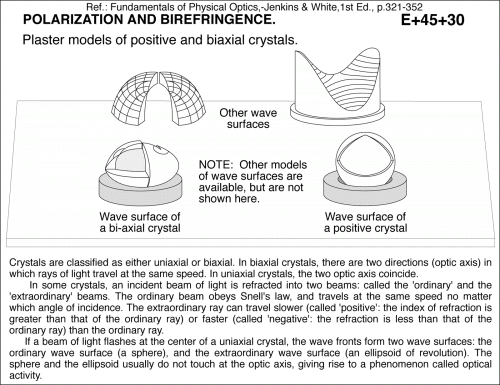Plaster models of positive and biaxial crystals.
Primary tabs
Plaster models of positive and biaxial crystals. NOTE: Other models of wave surfaces are available, but are not shown here. Crystals are classified as either uniaxial or biaxial. In biaxial crystals, there are two directions (optic axis) in which rays of light travel at the same speed. In uniaxial crystals, the two optic axis coincide. In some crystals, an incident beam of light is refracted into two beams: called the 'ordinary' and the 'extraordinary' beams. The ordinary beam obeys Snell's law, and travels at the same speed no matter which angle of incidence. The extraordinary ray can travel slower (called 'positive': the index of refraction is greater than that of the ordinary ray) or faster (called 'negative': the refraction is less than that of the ordinary ray) than the ordinary ray. If a beam of light flashes at the center of a uniaxial crystal, the wave fronts form two wave surfaces: the ordinary wave surface (a sphere), and the extraordinary wave surface (an ellipsoid of revolution). The sphere and the ellipsoid usually do not touch at the optic axis, giving rise to a phenomenon called optical activity. Ref.: Fundamentals of Physical Optics,-Jenkins & White,1st Ed., p.321-352
UCB Index:
E+45+30
UCB Taxonomy:
PIRA Taxonomy:
Popularity:
- Log in to post comments

